“Bring me Sensi, even without legs.” A telling statement on Inter loanee Stefano Sensi’s footballing intelligence that his agent Giuseppe Riso recently claimed one manager in England had said when speaking about the 24-year-old Italian midfielder. On loan from fellow Serie A side Sassuolo, and after some excellent early performances for Inter, Sensi’s season has unfortunately been ravaged by injury. In what has been a stop-start campaign, Sensi played the first seven games, winning six and contributing with three goals and two assists. From then on he missed nine games with an abductor tear, returned for five, and was re-injured up until the season was stopped due to the COVID-19 outbreak.
In just over 1000 minutes for Inter this season (12 games), it seems Sensi may have done enough to convince the Nerazzurri to trigger their option to buy him at the end of the 2019/20 campaign. The midfielder’s intelligence, spatial awareness, passing distribution, and creativity have impressed Inter manager Antonio Conte who is said to be ‘crazy about him,’ and has resulted in him earning his first full international caps for Italy this season.
This scout report will use tactical analysis and statistics to examine why Stefano Sensi should be a transfer target that Inter considers a priority this summer analysing his strengths and areas for development with regard to his role at Inter Milan.
Role for Inter
Sensi has predominantly played as a left-sided central midfielder this season in Antonio Conte’s 3-5-2 formation. When building the attack from their defensive third, Inter often has defensive midfielder Marcelo Brozović drop deep to receive the ball. As this happens, Inter’s two centre midfielders will drift wide in an attempt to spread the opposition midfield and play penetrative passes directly into the front two of Romelu Lukaku and Lautaro Martínez. This provides some context to Sensi’s heatmap below as we can see he covers the majority of the left side of the pitch from box to box (red colour) and is often positioned out on the left flank also.
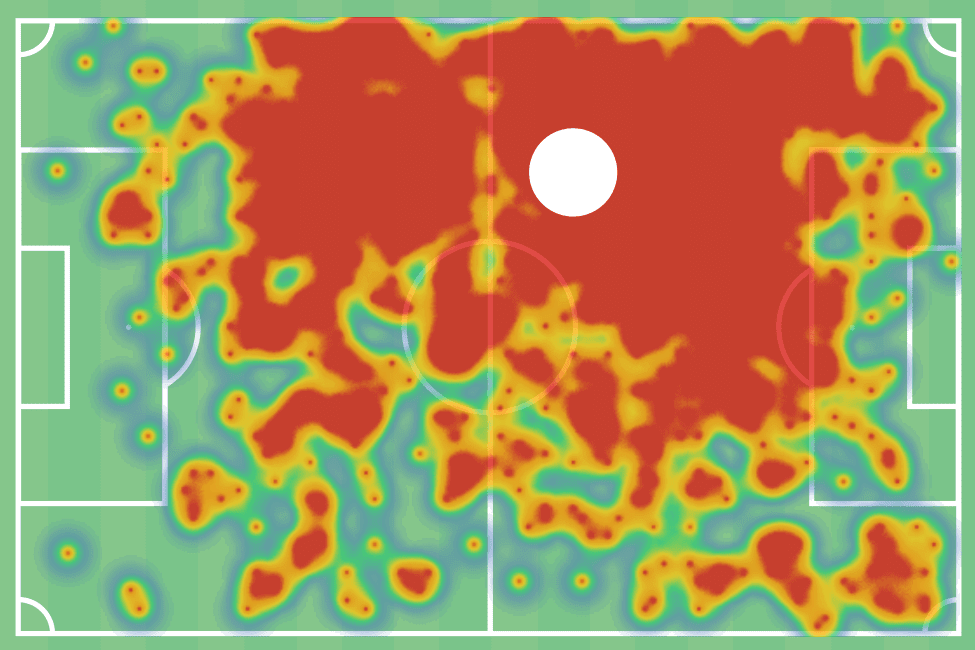
When Inter’s centre-backs and defensive midfielder Brozovic cannot play directly into their strikers, they look to play to the attacking wing-backs or the central midfielders in advanced positions. Often positioning himself in the left half-space can lead to opportunities to combine with the wing-back in 2 vs 1 situations down the left flank. Additionally, by vacating the central area, this affords opportunities for Sensi to play into Martinez or Lukaku’s feet. By receiving in the half-space or flank, opposing midfielders are drawn out of position and often not compact enough to prevent penetrative vertical passes. Under Conte’s tactics, as the ball arrives into the front two, this is a trigger for the advanced central midfielders such as Sensi to provide support and combine in the final third as we will discuss later on.
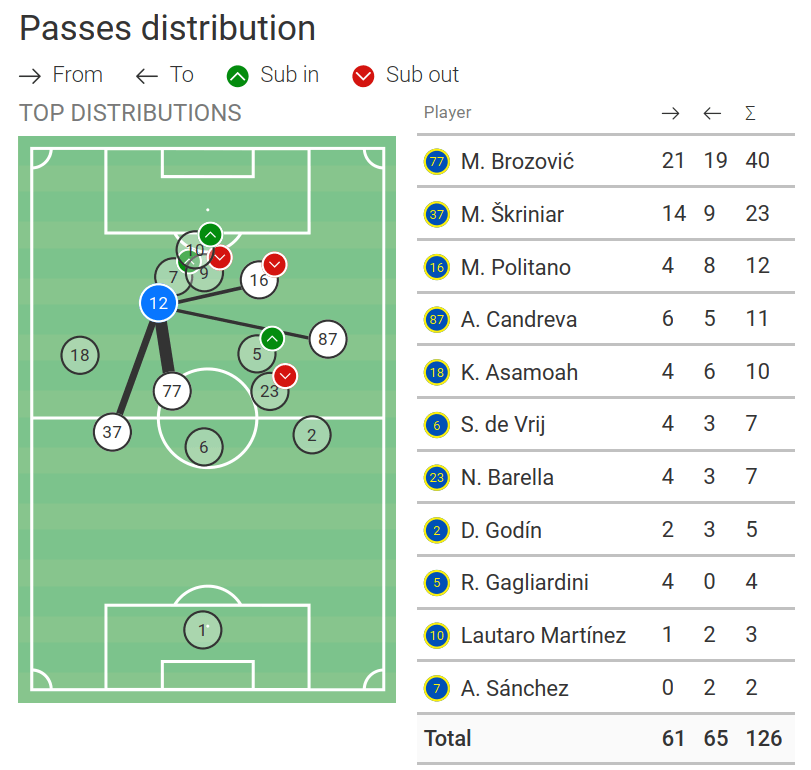
Above we can see a passing distribution map highlighting the players Sensi combined with most frequently with during the Serie A match against Udinese earlier this season. As mentioned previously, we can see Sensi’s strongest passing combinations were with defensive midfielder Brozović and centre-back Milan Škriniar. What is also evident here is Sensi’s advanced position he often takes up when receiving passes in the left half-space during the build-up. Sensi often takes up positions which affords positional superiority as he finds himself in between the lines. Consequently, a pass into Sensi often breaks the oppositions’ first line of pressure eliminating their initial press and allowing Inter to progress up the field.
Spatial Awareness results in positional superiority
There has been evidence to show that an increase in a player’s off-ball exploration (scanning) before receiving the ball, leads to improved performance with the ball, more forward passes, increased likelihood of a successful pass, and faster passes, (McGukian et al., 2018; Eldridge et al., 2013; Jordet et al., 2012). One of Sensi’s standout attributes is his excellent spatial awareness which often leads to positional superiority: players taking up advantageous positions in relation to their opponents. This is a critical part of Sensi’s game. Due to his relatively small size at 1.68cm and 62kg, engaging in 1 vs 1 duel may not be favourable for Sensi as he could get overpowered by bigger, stronger midfielders. This is highlighted by the fact that in offensive duels, Sensi engages in 8.01 per 90 placing him 40th amongst midfielders in Serie A. Due to his exceptional awareness and positioning, Sensi, for the most part, can avoid this by being one step ahead and playing his way out of small spaces similar to a player like Xavi for Barcelona.
This can be seen below as Brozović is in possession of the ball on the halfway line looking for a forward pass, similar to the pass distribution map mentioned previously. We can see Sensi positioned behind the first line of pressure, scanning. After recognising where the pressure is coming from before he receives the ball, Sensi drifts wide in order to receive a pass whilst maintaining position in between the lines.

Below, Brozović finds Sensi with a forward pass. As a result of Sensi’s position, Inter has entered into Udinese’s half and he has received away from pressure. In doing this Sensi has forced the Udinese midfield to retreat giving him the option to combine down the left flank with Kwadwo Asamoah, or pass back into Brozović who now has more time and space inside the opposition half to advance. Sensi’s positioning can go unnoticed, however, this positioning can be an integral part of Inter’s build-up play in the middle third.

Another example below highlights Sensi’s intelligent positioning when Inter builds from the defensive third. He recognises Udinese have committed significant numbers forward to apply pressure early on in the game and subsequently drops slightly deeper to receive the ball in behind the five players applying pressure. Sensi’s position means Asamoah’s pass effectively takes five players out of the game.

Sensi realises he is in space and is able to turn and play forward as Inter enter the opposition half, see below.

Receiving under pressure
Despite being excellent at finding spaces in between the lines giving him more time on the ball and meaning Inter can eliminate the oppositions’ pressing forwards and midfielders, Sensi is also extremely comfortable receiving under pressure. Once again, his spatial awareness and scanning mean he can manipulate opposition by drawing them out and disrupting their defensive shape when attacking. This often creates spaces higher up the pitch which can be exploited.
Below, Sensi drops deep to receive the ball on this occasion drawing the opposing centre-midfielder out with him. Although coming shortly to receive the ball, Sensi maintains his position just behind the opponents’ initial line of pressure.
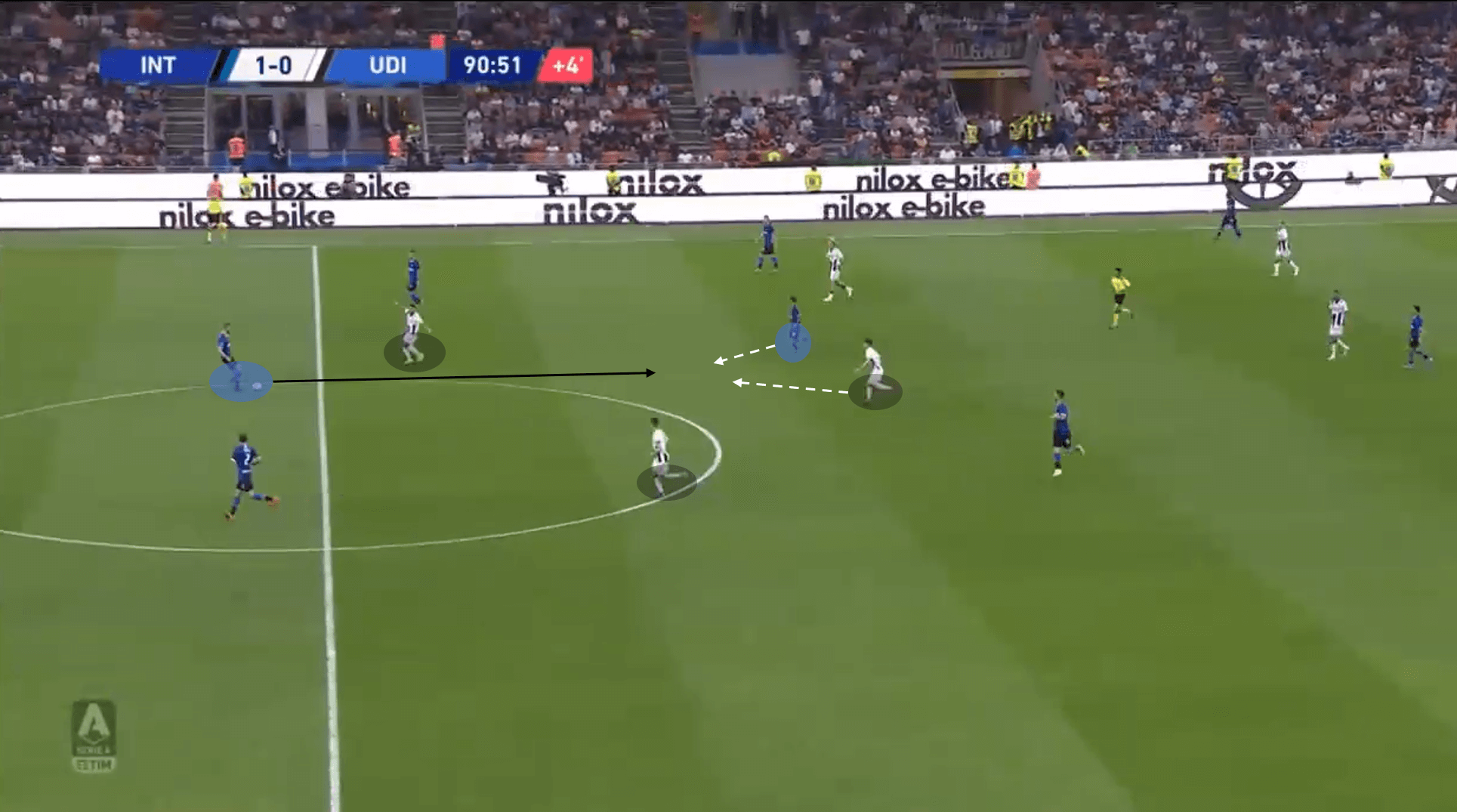
Sensi is aware of the pressure coming over his left shoulder and in one touch sets the ball back to his centre-back. Always one move ahead, he instantly makes a second movement in behind the defender who has just pressured him to exploit the space that was created in behind him as a result of him drawing him out of his midfield line, see below.
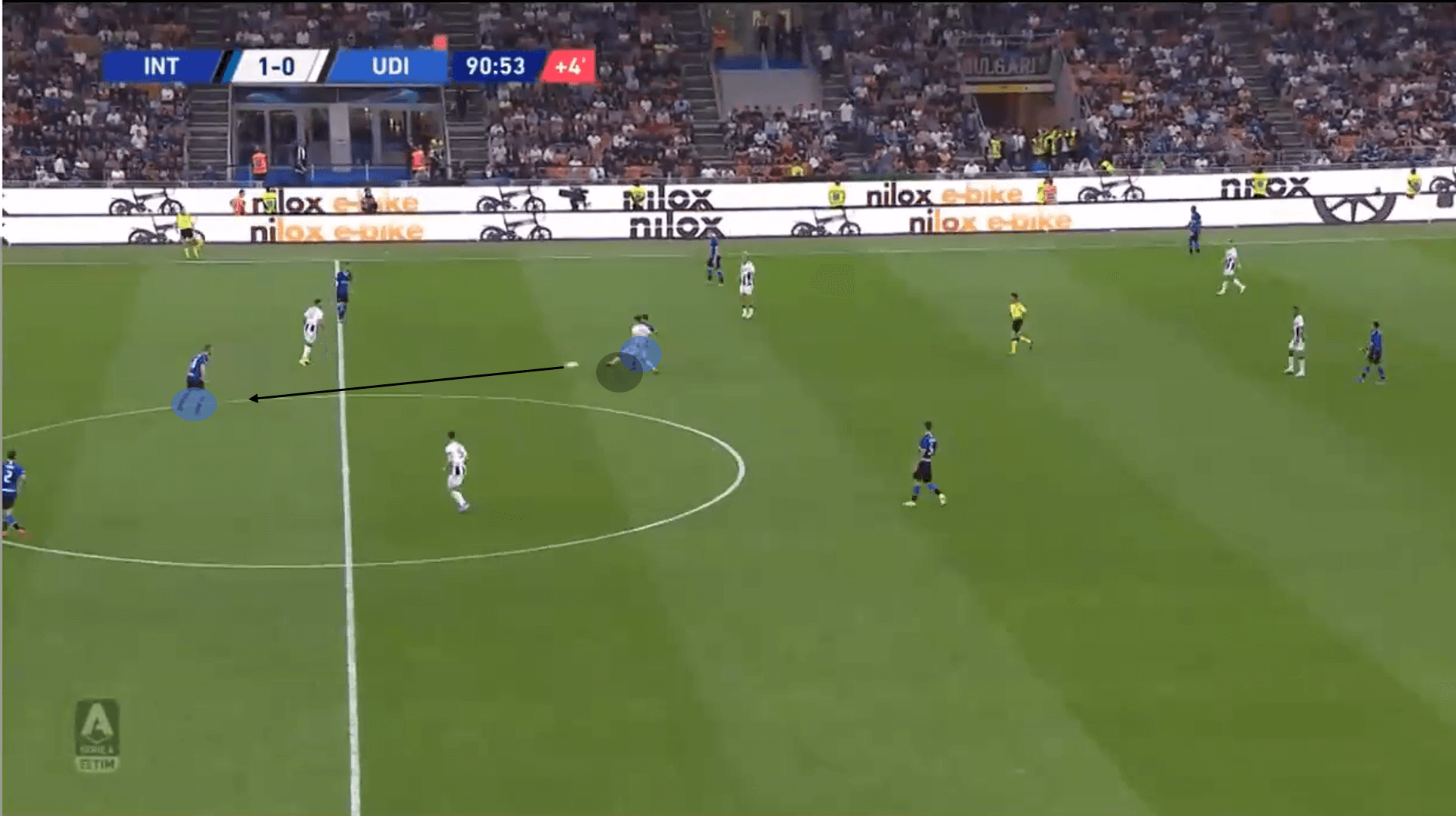
The Udinese midfielder continues his pressure onto the Inter centre-back creating a situational front three, see below. Consequently, once the ball is returned to Sensi he now has a significant amount of space to attack and the Udinese defence is exposed with no protection from their midfield.

Sensi’s awareness is also reflective of his excellent receiving skills. Upon receiving the ball, in a short amount of time, players must consider the space they are in, where their teammates are, and where the opponent is before the ball arrives. Sensi’s ability to do this consistently often means his first touch is away from pressure, perfectly weighted, and is taken into the direction he would like to play next.
In the picture below we can see Inter being pressed in a man-oriented fashion. Despite this, Sensi is still trusted to receive it under significant pressure that is arriving from his left side as the opponent has committed to winning the ball back in Inter’s half.
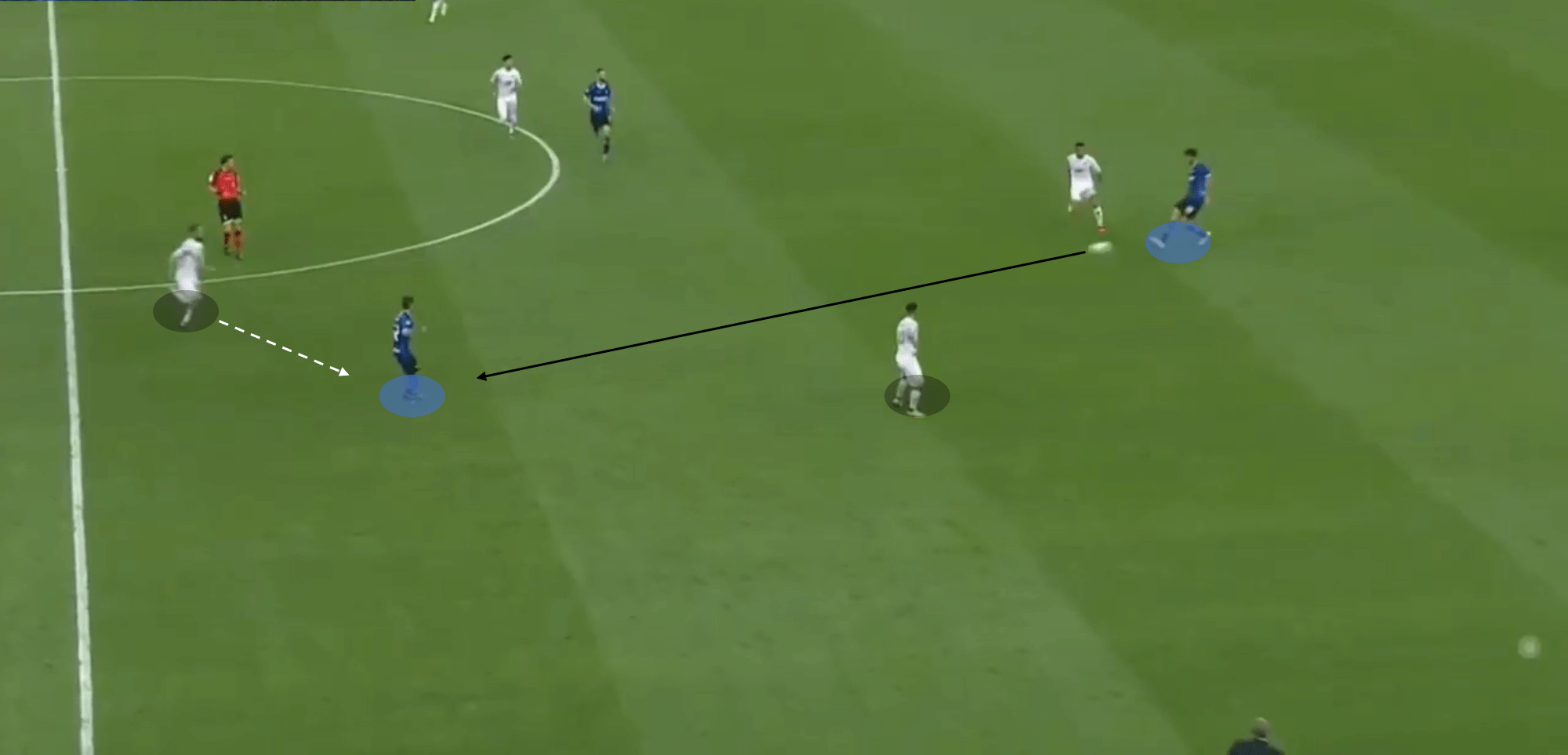
Once again, Sensi recognises the pressure coming and in attempt to avoid entering into a physical duel lets the ball roll across his body and takes his touch in behind the opponent. This one move relieves Inter from the intense pressure they were under and takes up to six players out of the game as he advances up the field to initiate an Inter attack.
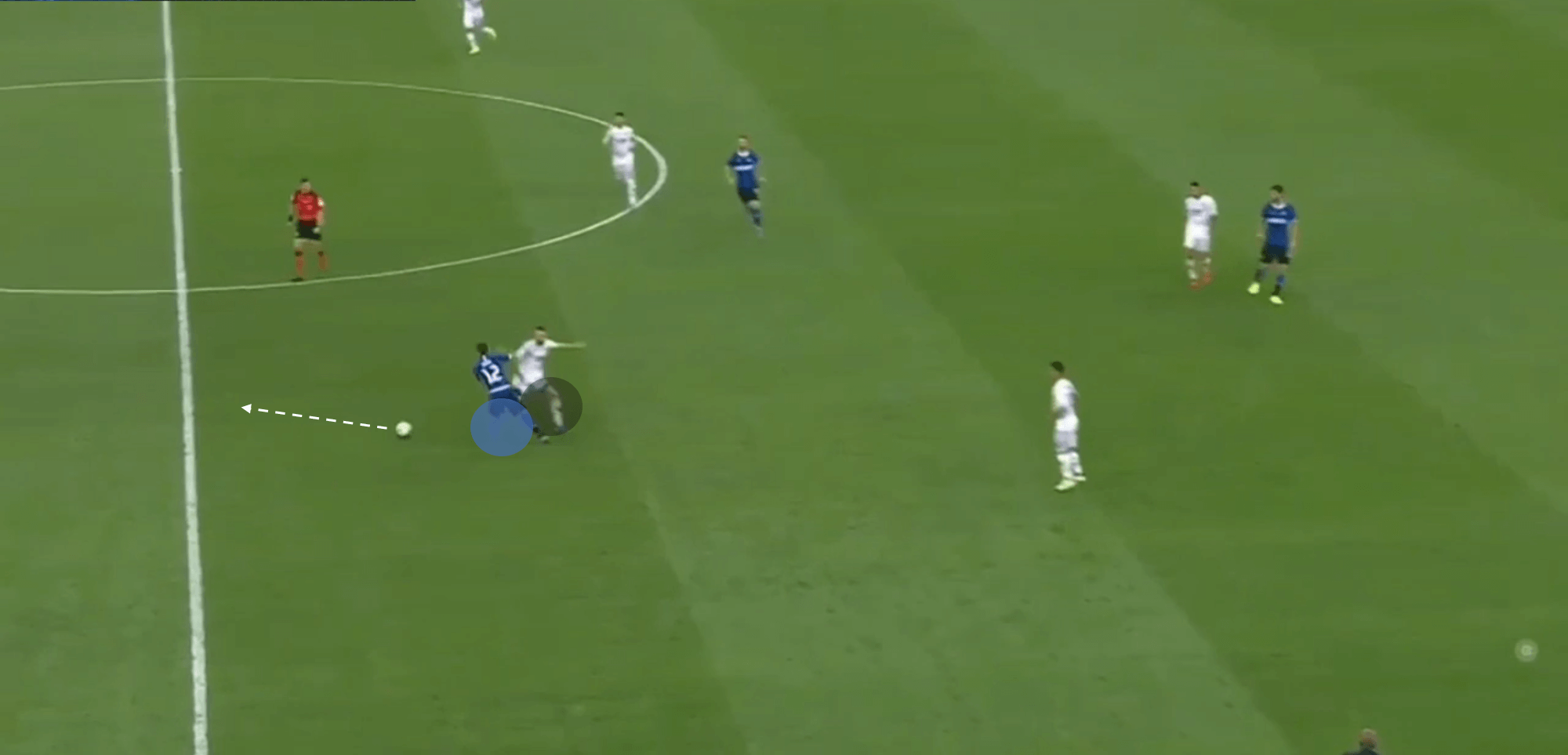
Impact on ball progression
We have discussed Sensi’s role for Inter and highlighted his spatial awareness and positioning as two attributes which are extremely valuable to Inter in possession. However, what does he do when he gets it? Sensi is an extremely accurate passer and has contributed heavily to Inter’s ball progression. Sensi sits in joint 8th for deep completions (passes that are received within a 20m radius of the opponent goal line), amongst Serie A midfielders averaging 1.88 per 90. In addition, his passing accuracy is 86.62%, just 4.25% less than first place Diego Demme. It must be noted that Sensi does average significantly fewer passes per 90 than Demme however his small sample size of games due to injury could impact this also.
To fully appreciate a midfielders’ contributions to their team, Opta sports have used a metric known as sequences, similar to xG Chain. Sequences are classified as passages of play belonging to one team, and ending in a shot, defensive action, or stoppage in play. Performing analysis on a player using sequences may allow for a more effective evaluation of a players’ contributions and give credit to players who may have previously been missed. An analysis was completed by Opta Sports comparing Italian great Andrea Pirlo during his time at Juventus and AC Milan, with Sensi. Interestingly, when searching for the most impactful midfielders in Serie A under 24-years-old using sequences, Sensi came out on top over the last three seasons. He showed a similar amount of sequences started to Pirlo averaging 11.6 compared to Pirlo’s 11.7, with a respectable Expected Goals (xG) output for sequences started.
Combination play with front two
In addition to his impact on build-up play, Sensi also provides high value within the final third. Passes into Inter’s strikers are seen as a trigger for supporting midfielders and wing-backs to support, combine, and create penalty box entries. Sensi is excellent at combining with the front two and has excellent anticipation, often resulting in unmarked arrivals into the dangerous ‘zone 14’ just outside the box. Here Sensi is able to link up with the likes of Lukaku and Martinez who frequently set the ball back to him before making a run in behind the defence, or, for Sensi to shoot himself.
Sensi has contributed with three goals this season placing him 7th amongst Serie A midfielders despite only playing 12 games. It is evident he is a willing shooter as although he sits in 15th for total shots when we examine average shot attempts per 90, Sensi averages 3.42 per match, only slightly off Lorenzo Insigne in 1st with 3.55 shots per 90. This highlights his confidence in his shooting ability which he justified with all three goals coming in his first seven appearances for Inter before getting injured.
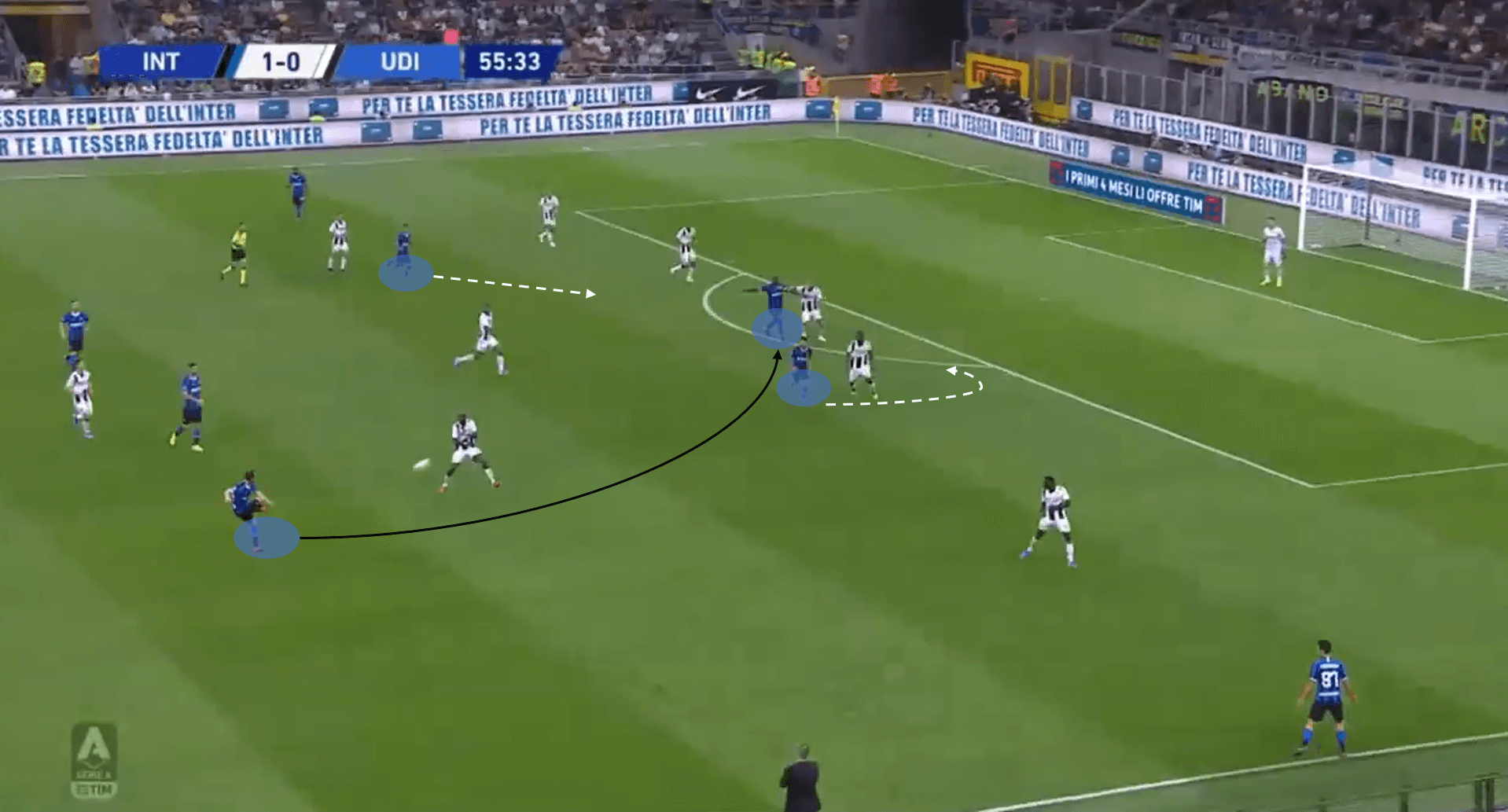
Above, we can see centre-back Diego Godin playing a pass straight into Lukaku on the edge of the box. Martinez expertly makes a run away from the ball which drags a centre-back with him, isolating Lukaku with his defender. As the ball travels, Sensi approaches on the blindside of the Udinese centre-backs and defensive midfielders arriving unmarked onto the edge of the box to provide support for Lukaku.
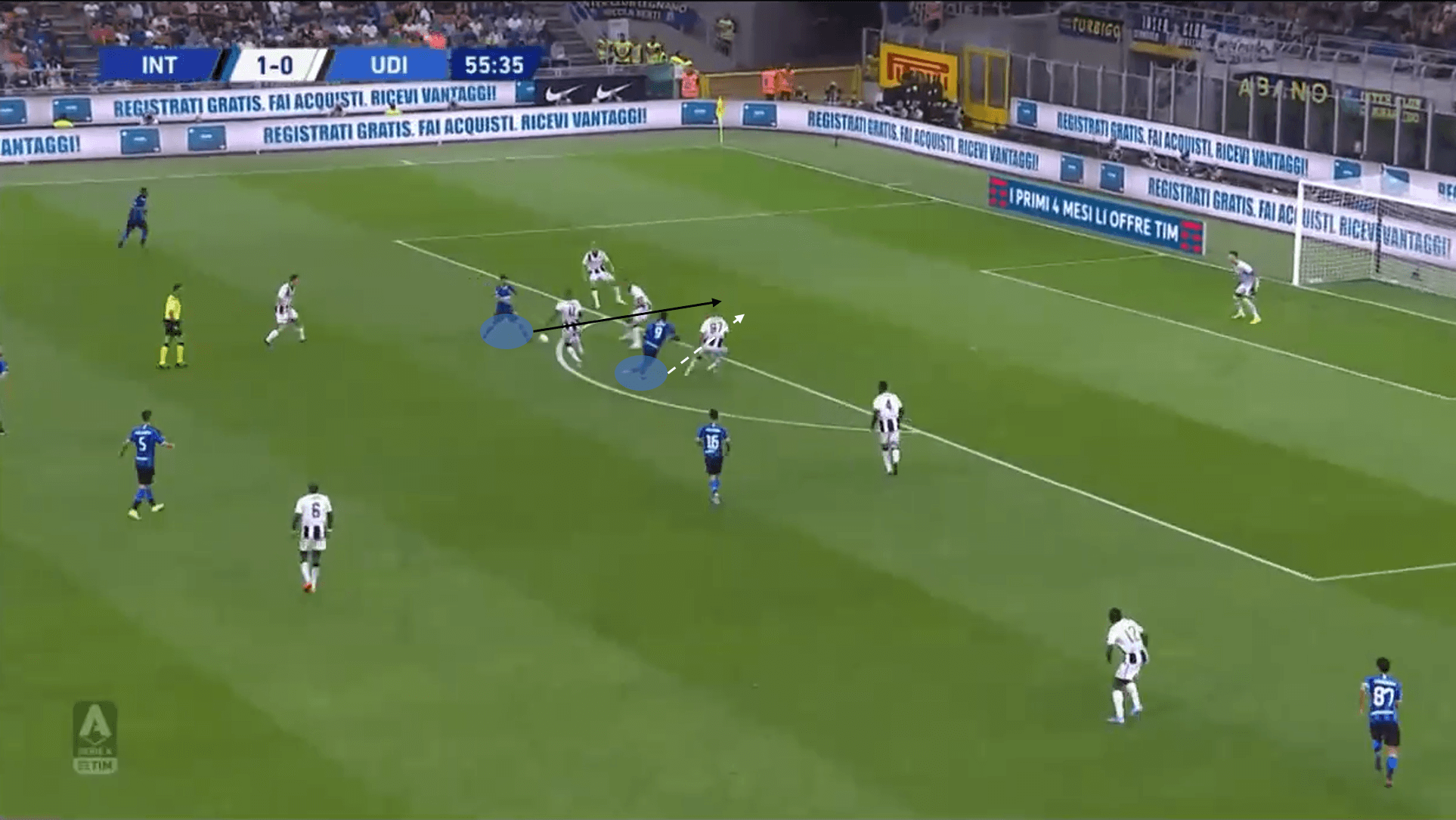
Lukaku recognises Sensi’s movement and sets the ball back to him before making a darting run into the box, see above. In one touch, Sensi plays the ball in behind the Udinese backline however, on this occasion, it is cut-out before Lukaku can reach it. Coming in from left to right meant Sensi could catch his opposing midfielder off guard as he was positioned on his blindside. Additionally, the anticipation and timing of his run as the ball travelled to Lukaku meant the striker could play back to him instantly, leaving Sensi with time to play a penetrative pass into the box, giving Udinese little time to react.
The image below provides an excellent example of Sensi’s awareness and positioning which make him extremely dangerous in the final third. Martinez makes a run into the right channel in behind the full-back, forcing the defenders to shuffle across. Sensi is intelligently positioned in between the defensive, and midfield line providing Inter with positional superiority. This position can be extremely difficult for opposing defenders who are not sure whether to step out of their backline to mark Sensi, and midfielders who must decide whether to drop and mark him or not, reluctantly allowing Inter space in front of them to advance into.
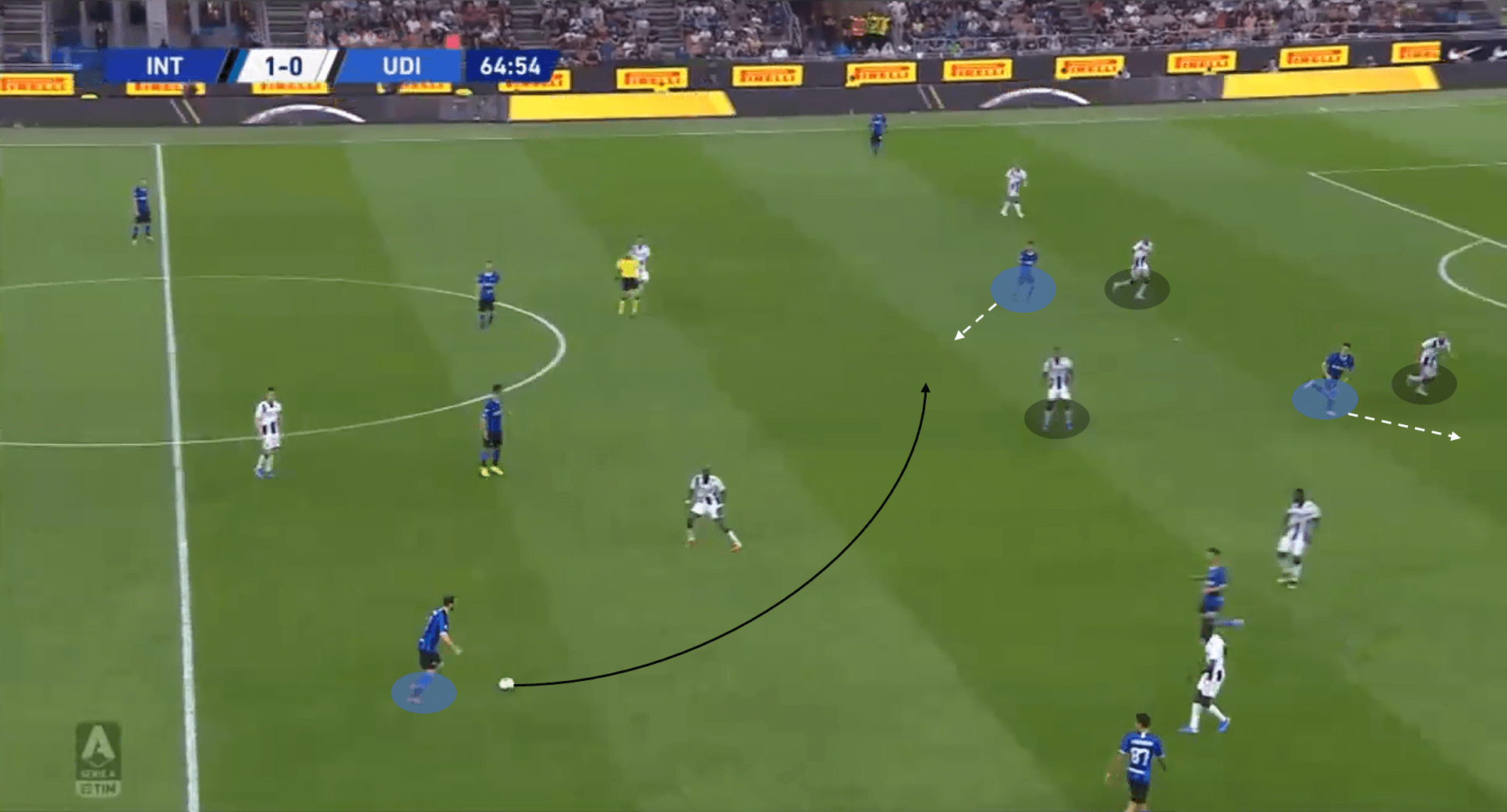
Below, Sensi pulls away from the opposition backline to receive the ball in between the midfield and defensive units. Martinez instantly cuts back inside to provide the support beyond Sensi. Here once again we can see Sensi’s fantastic spatial awareness as he decides to play directly into Martinez with one touch before the opposition has any time to react to Godin’s pass and put any pressure onto him. Sensi’s positioning, awareness, decision making and passing ability disrupts Udinese’s defensive organisation and creates space for others around him like Martinez in this case.
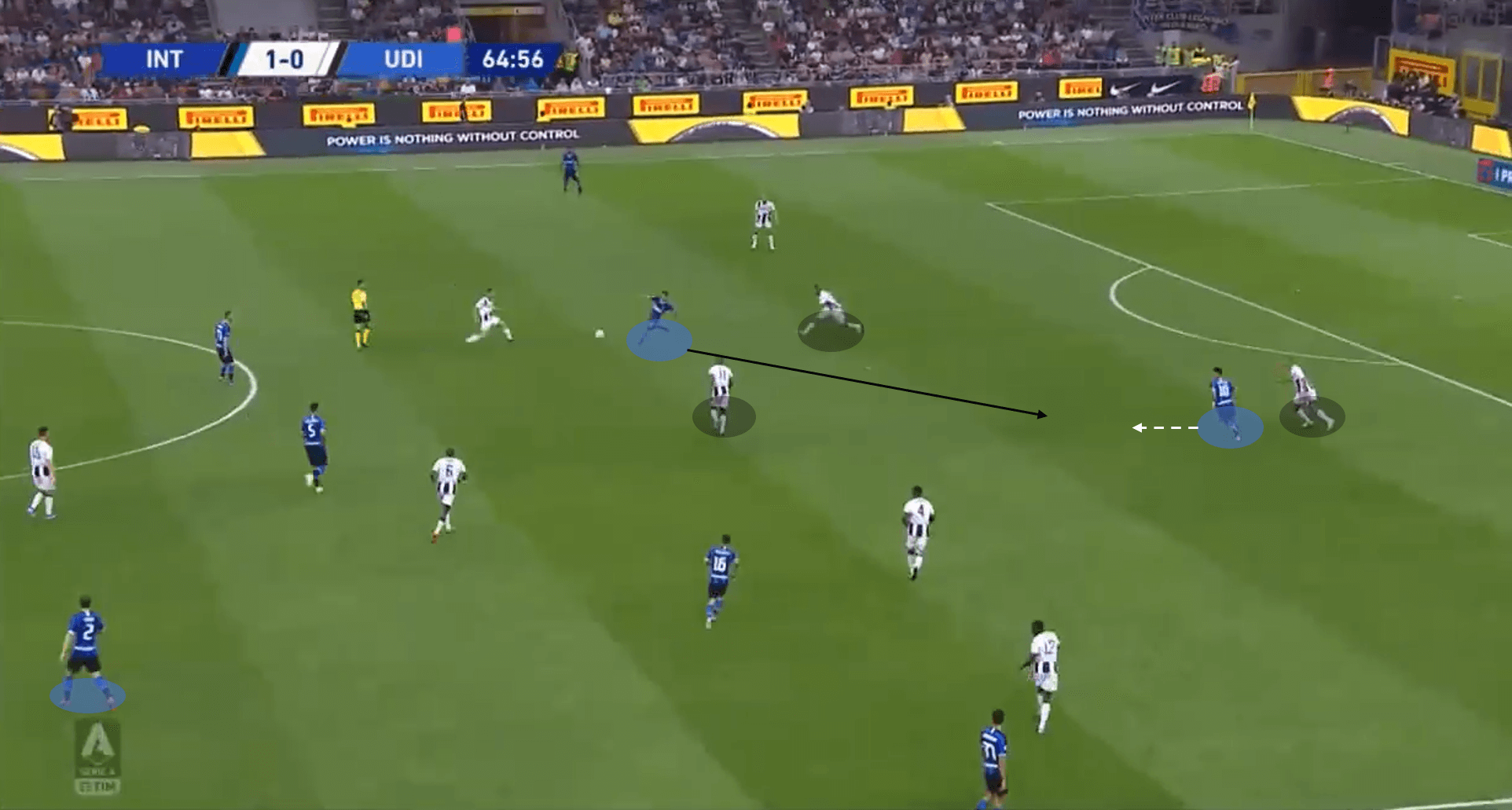
Attacking transition – counterattacks
Sensi has also proven he can be extremely impactful when in possession during attacking transition. Similar to sequences used by Opta, xG chains can be used to credit attacking contributions outside of shots and assists and take player involvement during earlier stages of attacking moves into account. In the pass map below with regards to actions in counterattacks, Sensi has one of the highest xG chains in counterattacks per 90 of all players within the Serie A of 0.01, and % of xGChain in counterattacks 1.79, as seen in the graph to the right.
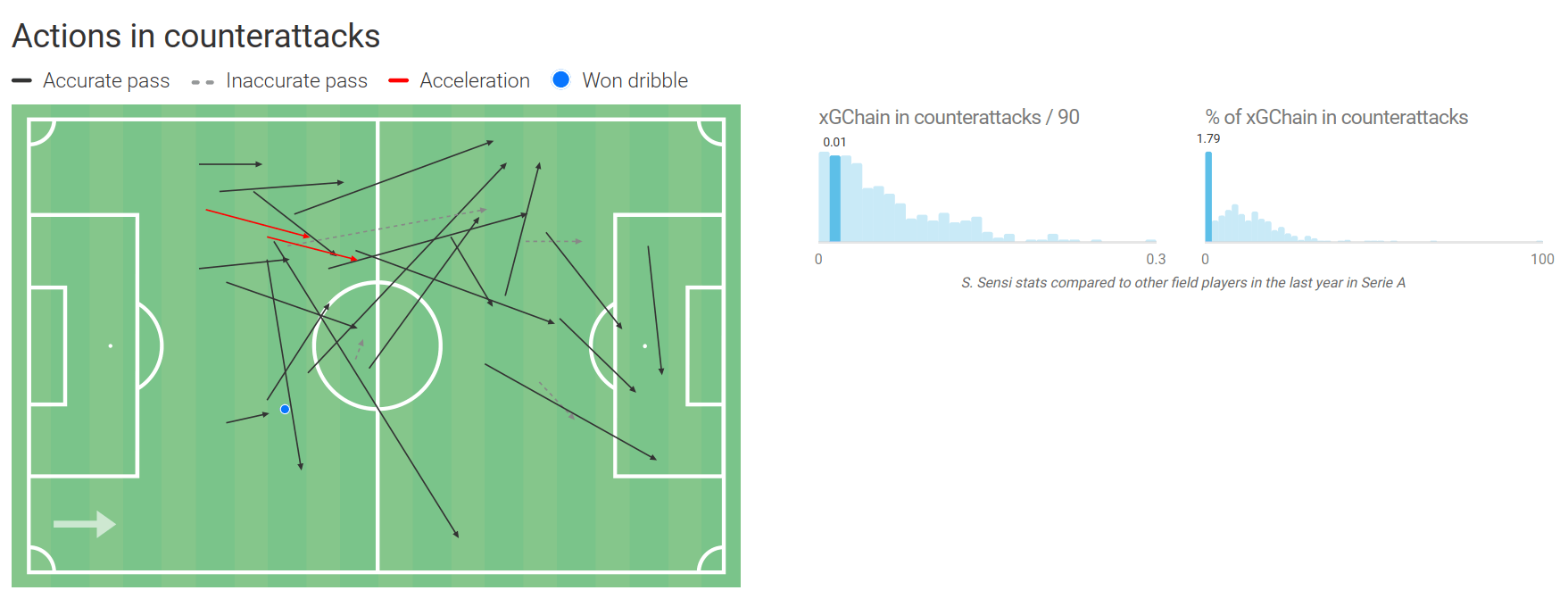
When examining the pass map (above, left) further, we can see just how direct Sensi is during this phase of the game. A principle of ‘forward first’ seems to be heavily adopted in these situations as every action he has completed has been in a forward direction in an attempt to advance the team. This allows Inter to expose any disorganization of the opposition before they get back into their defensive shape.
Areas for development
With regards to Sensi’s defensive contributions, both his defensive duels and aerial duels are below a 50% success rate. Although aerial duels may not be an area he is expected to thrive in due to his height, defensive duels and recoveries could be an aspect of his game to improve. Sensi lies 88th amongst midfielders for defensive recoveries and 49th in counter-pressing recoveries which could be something that he could contribute to more going forward during the defensive transition. That said, it must be noted that Sensi’s role is as an advanced central midfielder and Conte’s tactics often mean Inter have adequate cover defensively playing with three centre-backs, in addition to defensive midfielder Brozović.
It must also be noted that Sensi’s physical fitness and strength could be something to be improved upon based on his injuries sustained this season. Sensi began the season as one of the most impressive midfielders in Europe, let alone Serie A before being sidelined for nine games. It was only after returning for five games that Sensi sustained another injury before the COVID-19 break. This time during lockdown is likely to have given him time to recover/strengthen and fortunately the injuries were not long term meaning we can expect him to get more minutes upon the return of Serie A.
Conclusion
At only 24-years-old it cannot be denied that Stefano Sensi is one of Europe’s most exciting midfield prospects which Inter will be keen to keep hold of if they intend to challenge titleholders Juventus. This sentiment has been reflected by Sassuolo’s CEO Giovanni Carnevali who when asked about whether Inter will take up their option to sign Sensi stated he had ‘no doubt about it.’ Sensi’s awareness, anticipation and decision making coupled with his passing, receiving and shooting attributes make him a valuable asset to Inter and if signed, will no doubt contribute significantly providing he can remain injury-free.





Comments